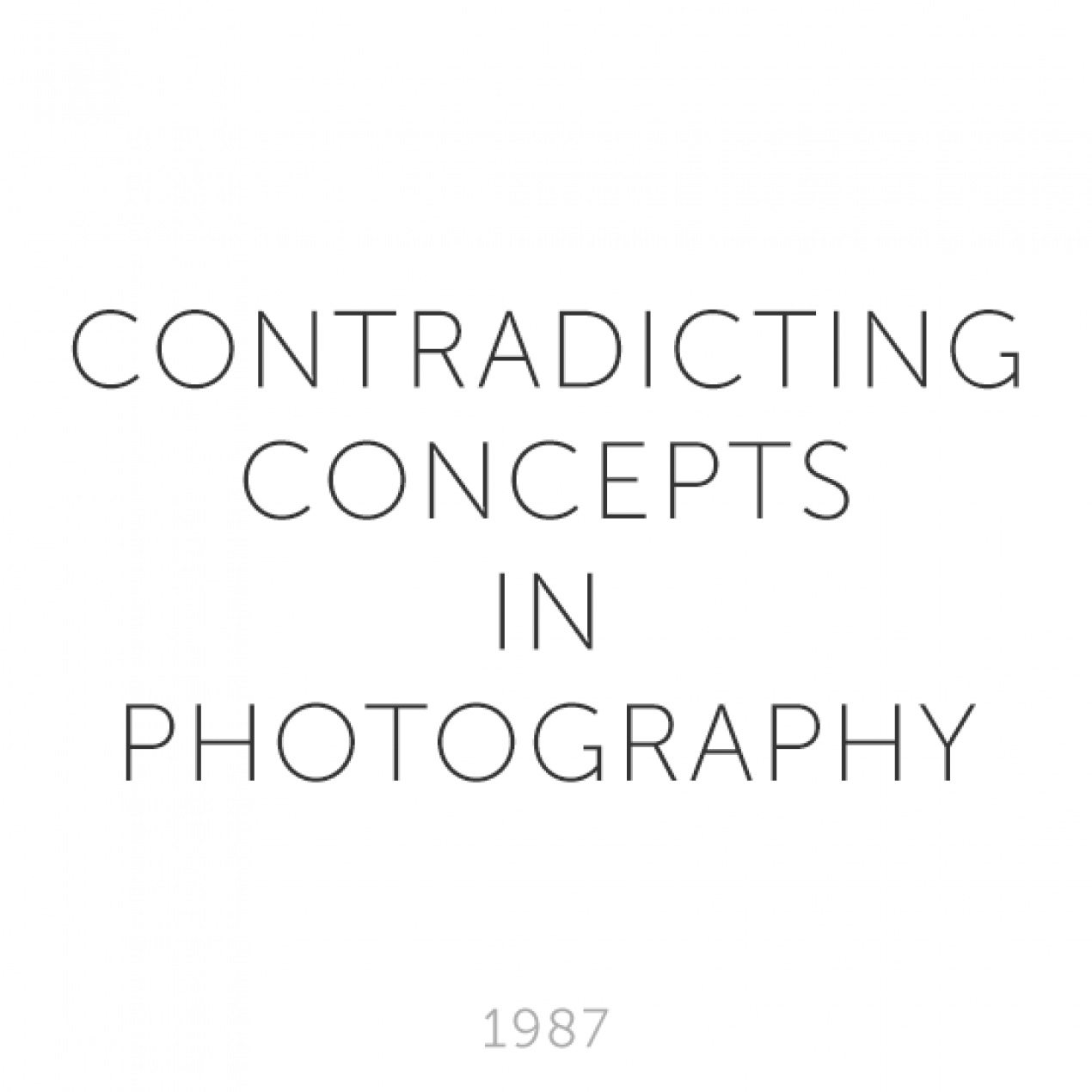* İFSAK, Photograph/Cinema Magazine, Issue: March 9, 1987
In recent years, no important steps have been taken to unite the work in line with the pursuits of new reality that has become popular along with the traditional photography understanding under a single concept, until today in our country. We have only seen individual outbursts because associations that gather wide masses, have not created a setting for serious debate on this topic. Unless this issue is opened for debate to the masses, it seems that uncertainty and chaos will continue, which in the very near future will further complicate the resolution of the matter by current concepts being added new ones. In the belief that the contradiction in concept chapter, I included afterwards as appendix to the paper I submitted to the 2nd Photography Symposium held by AFSAD (Ankara Photograph Artists Association) early January, will provide clarification to the subject in accordance with the concepts and will contribute to the creation of a debate setting, I deemed suitable to excerpt it fully hereto.
Our friend Samih Rifat -we all know him from his writing- also joined the efforts to rationalize the new reality attempted to be explained with concepts based on fiction or design according to certain people, and with creative concepts according to others, with his pictorialist photograph (pictorialism) concept in his article titled Fotografın İki Yolu in Sanat-Adam Magazine of February 86. We found ourselves yet again in chaos with the concept of pictorialism he unleashed. By the way, frankly speaking, it is interesting that my friend Samih as the person who first raised the issue of the new pursuits for realitys in our country, did not mention in his writing the concept of experimental photography, which I try to explain at every opportunity. All aside; the concepts fiction, design, creative, pictorial or pictorialist are not of explanatory and generic quality for the new reality in photography. Let us address all these concepts one by one in terms of clarifying the subject:
FICTION: Is a concept used in the language of cinema. Is a technical stage used to express, the harmonious combination and organization of the plans obtained during the production of a movie. This technological process used by cinema cannot explain the concept of the new reality of photography as a concept.
DESIGN: Includes all design/popularization of the communication system, i.e. visual and audio visual tools design principle. Just as my friend Samih said, it does not only make one think of the project concept of the art of architecture either, just: The graphic is based on design with its artistic entirety. There are departments under the name Industrial Products Design at Universities. Moreover, the basic principles of documentary and image selective traditional photography attitude are also based on design. This concept that comes to mind in every field related to man, does not render the new reality original.
CREATIVE: The passion for creation, is as old as mankind itself. All visual and audio visual arts have creativity in their texture. Beside other arts, describing the approach of photography to new reality as creative, makes the fact of creation appear as unique mere to this understanding, which would not be an accurate description.
PICTURESQUE (Pictorialism): Is derived from the word picture, commonly used in the field of picture; and is an understanding close to the expression of the picture and even including the definition like a picture, in the west. When the concept is approached in terms of linguistics: the suffix -esque added to the word picture is drawing us into uncertainty. Neither picture nor photography! But it does not resolve which one. When our friend Samih came up with this concept and definition, -I suppose- he did not realize he was falling into a full-fledged conceptual contradiction. If for a short while we set aside searching a concept for the new understanding of photography, and take a look at a mixture of the romanticism, expressionist/expressionism and impressionist/impressionism movements of painting we frequently view in recent times, that is to say, nondescript works again resolved within a single frame without interference, we will also have to find new concepts for these documentary quality works. Here are a few examples to this approach: Sedat Uzaras’ work, awarded with the first prize in color printing at the 2nd State Photography Competition, and Izzet Keribar’s work awarded with the first prize in the Etap Hotels competition.. And many more..
From the field of painting, a new Turner, Delecaroix or from the new impressionists Signac and Seurat for today; from the field of photography, Watzek’s still life in 1896, the Park View of Henneberg in 1897 and the Urban Landscape of Bernhard Troch from Hamburg in 1907, are sought to be recreated. Nevertheless today’s technological possibilities do not give the picturesque flavor given by the rubber printing/Gummidruck, carried out with 3 different films in those years!. I believe that it would be much more beneficial if my friend Samih describes the works carried out in line with this understanding as picturesque or pictorial. Then again, I have always avoided explaining the impressionist movement of documentary photography and the search for new reality with this or that concept of painting art. There is no point in pitting painting and photography of different development processes, technologies, reality pursuits, approaches to the concept of moment and visual languages, -as in the past- against each other.
Works directed towards the exploration for new reality that has gained prevalence in our country are experimental. This concept, which is expressed as experimental in foreign language, is described by natural sciences as:
“experiment is to prove the truth of the findings that will emerge as a result of the research based on the objective by a predetermined method and thus to ensure the development of the information within the scope of the research.”
Its definition and explanation in Art History is as follows:
“to go out of the defined frame, to reach another objective reality beyond everyday life; to live the freedom, to obliterate the fear of exclusion, addiction, obligation and to put it behind. To ask why and how about everything, to live the past and the future at the same time.”
I would like to briefly convey the description of Experimental Photography / Experimentelle Fotografie on page 84 of the Lexikon der Fotografie, a dictionary of photography, published by Du Mont in 1978.
“There are examples on photogram and photomontage made half-jokingly before 1850. In the course of the development of kinematography, the experimental activities of Eadweard Muybridge (1830-1904) in the artistic platform are among the first examples. Along with the development of classical photography within the artistic area in the 19th century, experimental photography was able to achieve this only in the 20th century. Schadography / schadographie and rayogram / rayograms, clip art /collage and photomounting / photomontages of dadaists and surrealists, for today contribute to the addition of new forms of expression to the art of photography. Today, the methods used in experimental photography -due to its versatile nature- have expanded to that degree that we will only be able to mention a few here: The qualities of the enhanced black/white and color films, provide the photographer with the ability to manipulate while shooting an object or an event he considers to visualize in accordance with a predetermined idea. From these possibilities we encounter, being each technological methods out-and-out, in accordance with the purpose the proper use of the multiple shot method on the same film plane, the simultaneous or separate printing method carried out by combining two or more films (sandwich-technique), the sandwich-film method composed by applying total or local chemical reduction to two or more films, the mask method applied during shooting or afterwards in the darkroom, the infrared material enabling the color and contrast change, will convey us to spectacular realities“
Experimental photography does not allow for any restrictions or limitations when using these methods; it tries to be as free as possible from the mechanics and censorship of the mind. For this reason, it is necessary to mention experimental photography as a set of images which will lead the individual to an internal reality beyond daily life. The basic principle of the artistic language that it wants to reach is the creative idea, determined as thesis-hypothesis or thought. In the theoretical platform, the below sequence is followed in identifying the creative idea:
1. Understanding the problem
1.1. Problem: Definition of the problem,
1.2. Preparation: Collecting and resolving all data related to the problem,
2. Researching and determining the idea
2.1. Generating ideas,
2.2. Developing the ideas,
Selection is made from various ideas emerging as a result of idea generation; new ideas may be added, changed or combined and reprocessed.
3. Finding a solution
3.1. Examination of solutions found,
3.2. Determination and adoption of the final solution,
4. Converting the solution into visual language.
The conversion of the creative idea in the form of thought into the visual language depends on the complete collection of the information within the subject to be examined. For this, the study requires a certain process; certain research based on methodology in this process.
Today, in our country, the experimental and moment conflict, lacking tolerance and flexibility, is intended to be maintained to reach polarization. This is the real picture that emerged after the 2nd Photograph Symposium organized by AFSAD. We, as experimentalists, in contrast to those opposed to experimental photography, see photography as a whole tool, do not deny the documentary photography fulfilling the function of imaging the moment in this entirety; however, we want to bring forth the language difference in reaching the artistic message. It should also be emphasized that; if art was created within a short period of time, as the hundred and twenty fifth of a second, we would have to describe all photo-lovers as artists, which would not be a right logic. Historical development clearly shows what belongs where. Apart from that, I believe that it is incomprehensible to confuse young minds, to heighten their awareness according to strict rules.
“…where, in which society there is a head who has made it his business to brag about the past, who regards conventionality a virtue, and who has others gathering around him, there will be those not able to hand down a product of civilization to be proud of, worth mentioning. Halting, stalling, carrying the old into the future as a meaningless load, is out of question for a productive, creative head…” ¹
¹ EYÜBOĞLU, İsmet Zeki – KIYI MAGAZINE, January 87, “Katılaşmış Başlar“, Article, Issue: 10, Pg: 3
January 1987







